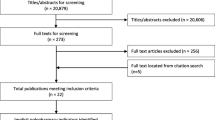Abstract
Objective
The aims of this study were to analyse (1) if it is possible to classify general practitioners (GPs) or groups of practitioners (practice units) as overall narrow or wide prescribers and (2) to what extent the size of practice drug formularies is associated with general prescribing behaviour, practice activity and demography.
Methods
Data were retrieved from the Odense University Pharmacoepidemiologic Database (OPED) and the prescribing patterns of 177 practice units were analysed in a 4-year period including 2000 and 2003. We characterised the drug repertoire for new treatments using a Formulary Diversity Scale based on two formulary measures, the DU 90% and the Formulary Selectivity Index. Multiple regressions were used to analyse the association between formulary size and practice characteristics.
Results
The final Formulary Diversity Scale comprised 15 therapeutic drug groups and 151 different analogues. The average score based on the DU 90% segment was 46 drugs (range: 28–65) corresponding to 30% of drugs available. Using the Formulary Selectivity Index the average diversity score was 0.70. Practices with a high number of patients and a high percentage of elderly patients were more likely to use a wide range of drugs.
Conclusion
The Formulary Diversity Scale revealed wide variation between practice units, indicating the existence of both overall narrow and wide prescribers among GPs. The number of patients attending the practice and the percentage of elderly patients were directly associated with the use of more analogues.
Similar content being viewed by others
References
Chinburapa V, Larson LN, Brucks M, Draugalis J, Bootman JL, Puto CP (1993) Physician prescribing decisions: the effects of situational involvement and task complexity on information acquisition and decision making. Soc Sci Med 136:1473–1482
de Vries TPGM, Henning RHHH, Fresle DA (1994) Guide to good prescribing. A practical manual. World Health Organization. Action Programme on Essential Drugs. World Health Organization, Geneva, pp 1–142
Robertson J, Fryer JL, O’Connell DL, Smith AJ, Henry DA (2001) Personal formularies. An index of prescribing quality? Eur J Clin Pharmacol 57:333–341
Bjerrum L, Bergman U (2000) Wide variation in the number of different drugs prescribed by general practitioners. A prescription database study. Scand J Prim Health Care 18:94–98
Buusman A, Kragstrup J, Andersen M (2005) General practitioners choose within a narrow range of drugs when initiating new treatments: a cohort study of cardiovascular drug formularies. Eur J Clin Pharmacol 61:651–656
Gaist D, Sorensen HT, Hallas J (1997) The Danish prescription registries. Dan Med Bull 44:445–448
Bergman U, Popa C, Tomson Y, Wettermark B, Einarson TR, Aberg H et al (1998) Drug utilization 90%-a simple method for assessing the quality of drug prescribing. Eur J Clin Pharmacol 54:113–118
WHO Collaborating Centre for Drug Statistics Methodology (2003) Guidelines for ATC classification and DDD assignment, 6th edn. Oslo
Bland JM, Altman DG (1997) Cronbach’s alpha. BMJ 314:572
Casey AT, Bland JM, Crockard HA (1996) Development of a functional scoring system for rheumatoid arthritis patients with cervical myelopathy. Ann Rheum Dis 55:901–906
Wettermark B, Pehrsson A, Jinnerot D, Bergman U (2003) Drug utilisation 90% profiles-a useful tool for quality assessment of prescribing in primary health care in Stockholm. Pharmacoepidemiol Drug Saf 12:499–510
Sondergaard J, Andersen M, Vach K, Kragstrup J, Maclure M, Gram LF (2002) Detailed postal feedback about prescribing to asthma patients combined with a guideline statement showed no impact: a randomised controlled trial. Eur J Clin Pharmacol 58:127–132
Bergman U, Andersen M, Vaccheri A, Bjerrum L, Wettermark B, Montanaro N (2000) Deviations from evidence-based prescribing of non-steroidal anti-inflammatory drugs in three European regions. Eur J Clin Pharmacol 56:269–272
Vlahovic-Palcevski V, Wettermark B, Bergman U (2002) Quality of non-steroidal anti-inflammatory drug prescribing in Croatia (Rijeka) and Sweden (Stockholm). Eur J Clin Pharmacol 58:209–214
McCarthy M, Wilson-Davis K, McGavock H (1992) Relationship between the number of partners in a general practice and the number of different drugs prescribed by that practice. Br J Gen Pract 42:10–12
Acknowledgements
The authors wish to thank Secretary Lise Stark for proofreading the manuscript, and Thorsten Kruse, Head of R & D Unit, Health Services Administration of the County of West-Zealand, for inspiring discussions. The study was funded by The Regional Institute for Health Sciences (grant no. 2002/10) and the Danish Research Foundation for General Practice (grant no. 70.205). The study complies with current laws in Denmark.
Author information
Authors and Affiliations
Corresponding author
Rights and permissions
About this article
Cite this article
Buusman, A., Kragstrup, J. & Andersen, M. Narrow and wide prescribers among general practitioners. Eur J Clin Pharmacol 62, 577–583 (2006). https://doi.org/10.1007/s00228-006-0126-y
Received:
Accepted:
Published:
Issue Date:
DOI: https://doi.org/10.1007/s00228-006-0126-y




